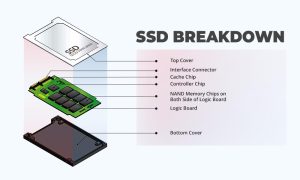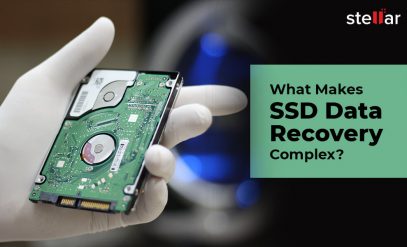[Solved]: How To Recover Data From Internal Structure Corrupted SSD?
| Summary: Learn how to recover data from internal structure corrupted SSD. This blog explores the causes and signs of internal structure corruption. It also mentions two methods for recovery. The methods to recover data from corrupted SSDs include data recovery software and professional SSD data recovery services from Stellar. |
|---|
Is it possible to recover data from internal structure corrupted SSD? Yes, it is.
In this blog, we will answer the following questions:
- Is It Possible To Recover Data From Internal Structure Corrupted SSD?
- What Causes Internal Structure Corruption In SSDs?
- How To Identify If Your SSD Has Internal Structure Corruption?
- How To Recover Data From Internal Structure Corrupted SSD? [2 Methods]
- A Case Study Of Recovering Data From An Internal Structure Corrupted SSD
- 4 Reasons To Trust Stellar SSD Data Recovery Service
- Other FAQs Around Internal Structure Corrupted SSD
Is It Possible To Recover Data From Internal Structure Corrupted SSD?
Recovering data from a corrupted SSD is technically possible. However, it is highly dependent on the extent and nature of the damage.
Unlike traditional hard drives, SSDs store data in NAND flash memory cells. And these are organized in a complex structure.

When the internal structure becomes corrupted, the data seems inaccessible.
But if only a few cells are corrupted, data recovery is feasible. Modern SSDs have extra cells for wear-leveling and error correction, aiding in recovery.
If critical components like the controller or firmware are damaged, recovery becomes complex, but still possible, with specialized tools and expertise.
Additional Reading: Data Recovery from Hynix 1TB SSD
Causes Of Internal Structure Corruption
Internal structure corruption in SSDs can occur due to several factors. Some common causes include:
- Sudden Power Failures or Voltage Spikes that cause interruptions during data writing
- Physical Damage like impact, extreme temperatures, etc.
- Firmware Issues like bugs or glitches
- Over time, the NAND flash memory cells wear out
- Conflicts or errors in the software managing the SSD can lead to internal structure corruption
- Virus or Malware Attacks
Accurate assessment and diagnosis play a pivotal role in the successful recovery of data from an internally corrupted SSD.
Recognizing the signs of internal structure corruption is the first step. Some telltale signs include:
- Files becoming inaccessible,
- Frequent error messages during file access, or
- System crashes.
If you notice any such signs, it’s time to act.
How To Recover Data From Internal Structure Corrupted SSD?
Before you even begin to attempt data recovery from your internal structure corrupted SSD, understand something important.
Disabling the TRIM Command for Data Recovery
What is the TRIM Command?
The TRIM command is a feature that helps your SSD manage unused data blocks, which enhances the drive’s efficiency and lifespan. However, it can be a hurdle when you’re trying to recover lost data.
Why Disable TRIM?
When TRIM is active, it permanently removes data that you’ve deleted, making it almost impossible to recover. Disabling TRIM can improve your chances of recovering lost files.
Steps to Disable TRIM:
- Open the Command Prompt as an administrator.
- Type fsutil behavior query DisableDeleteNotify.
- If the result is 0, TRIM is enabled. To disable it, type fsutil behavior set DisableDeleteNotify
- If you’re returned a value of zero (0), means TRIM is enabled.
- A value of (1), signifies that TRIM is disabled.
Risks Involved:
- Disabling TRIM can slow down your SSD’s performance over time.
- Make sure to re-enable it after you’ve recovered your data.
Next, you need to check whether:
- Your SSD is still working: Backup important data, connect the SSD to another computer, and try, if the problem persists then stop using the SSD.
- Your SSD has stopped working: Stop using the SSD.
Then follow the methods to recover data from internal structure corrupted SSD discussed below.
Methods Of Recovering Data From An Internal Structure Corrupted SSD
Method 1: Data Recovery Software
One of the most common approaches to recovering data from an internally corrupted SSD is to use specialized data recovery software. For example, Stellar Data Recovery Toolkit
The software solution is designed to handle various types of data loss scenarios, including internal structure corruption.
Limitations of Data Recovery Software for Corrupted SSDs
1. File System Corruption
- When the file system becomes corrupted or RAW, you can’t access the SSD, making data recovery difficult.
- Error messages like “No bootable device” or “No bootable medium” often appear, indicating corruption.
2. Firmware Failure
- Firmware updates can sometimes go wrong, causing the SSD to fail.
- In such cases, most SSDs automatically fall into a fail-safe mode, but data may still be lost.
3. Data Corruption
- Malware infections or bad sectors can corrupt data within the SSD.
- This can damage essential segments of the drive, making data recovery challenging.
4. Physical Damage
- While SSDs are robust, physical factors like heavy blows or water submersion can severely damage them.
- Such physical damage can make data recovery impossible.
In such cases, or when you’re not confident about using a data recovery utility, it’s better to let expert data recovery service professionals handle your corrupted SSD.
Method 2: SSD Data Recovery Service
When the corruption is severe, data recovery software might not suffice.
That’s when you should turn to a professional data recovery service, like Stellar SSD Data Recovery.
Our experts have a track record of recovering data from internal structure corrupted SSDs.

How does a standard SSD data recovery service process look like?
1. Initial Assessment: The service starts by evaluating your SSD to understand the level of corruption and the likelihood of successful data recovery.
2. Detailed Diagnosis: Experts then delve into the SSD’s internal structure to pinpoint the issues causing the corruption.
3. Attempted Repair: If possible, we try to fix logical or firmware issues to make the SSD accessible again.
4. Data Imaging: If repair isn’t an option, we create a sector-by-sector copy of the SSD’s data, known as an image.
5. Data Extraction: Specialized tools are used to pull data from this image. This can involve bypassing damaged areas or using advanced algorithms.
6. Verification: The integrity of the recovered data is checked to ensure it’s both complete and accurate.
7. Secure Delivery: The recovered data is then securely sent back to you, either through secure online channels or on an external storage device.
Case Study: Data Recovery From Internal Structure Corrupted Laptop SSD
Client: A BPO business that offers customer support, finance and accounting, and consultancy services to telecommunication, healthcare, retail, and manufacturing sectors in India.
Goal: Recover data from an internal structure corrupted laptop SSD drive.
Approach: Stellar Data Recovery retrieved data from the internally corrupted laptop SSD.
Challenges Faced:
- The laptop SSD (500 GB) experienced an unexpected shutdown, rendering it undetectable.
- The abrupt laptop failure added to the challenge of data recovery.
Stellar Data Recovery’s Process:
- Initial Analysis suggested that the SSD was not detected in BIOS. Thus, it was not possible to access data.
- In-depth analysis revealed that the internal structure of the SSD was corrupted.
- Stellar data recovery team employed specialized techniques. And ultimately, we located the data in high quality.
- Finally, we recovered all the data presented in a directory format.
Client Feedback:
The client expressed great satisfaction with Stellar’s services. They found our data recovery efforts highly effective.
4 Reasons To Trust Stellar SSD Data Recovery Service
1. Proven Track Record: 80% success rate 40k annual jobs performed. We’ve done it for several others and will do it for you too.
2. State-of-the-Art Cleanroom Labs: Cutting-edge class 100 cleanroom facilities. This ensures a controlled and contaminant-free environment for sensitive SSD recovery operations.
3. Data Privacy: Strict protocols to ensure your sensitive information remains 100% confidential.
4. No Data, No Charge: Our commitment to your satisfaction is evident through our “No Data, No Charge” policy. You only pay if we successfully recover your data.
FAQs
1. Can I attempt to recover data from a corrupted SSD at home?
Yes, you can attempt recovery at home. But it’s risky.
Using the data recovery software may help if the corruption is minor. However, for severe cases, professional data recovery services are safer and more effective.
2. How to improve the chances of recovering data from internal structure corrupted SSD?
You can improve the changes by:
- Stopping SSD Usage: Halt using the SSD immediately.
- Prioritize Backups: Regularly back up your data.
- Avoid DIY: Unless experienced, don’t attempt DIY recovery.
- Document Issues: Note down error messages and symptoms.
3. Are there any DIY methods to prevent internal structure corruption in SSDs?
Certainly, here are five DIY ways to prevent internal structure corruption in SSDs:
- Keep firmware updated.
- Use a reliable power source.
- Avoid excessive heat exposure.
- Regularly back up your data.
- Don’t fill the SSD to its maximum capacity.
Data recovery from an internally corrupted SSD is a complex process. Professional SSD data recovery offered by Stellar offers the best chance of success. So don’t panic and contact us to take the first step to recover data from internal structure corrupted SSD.







